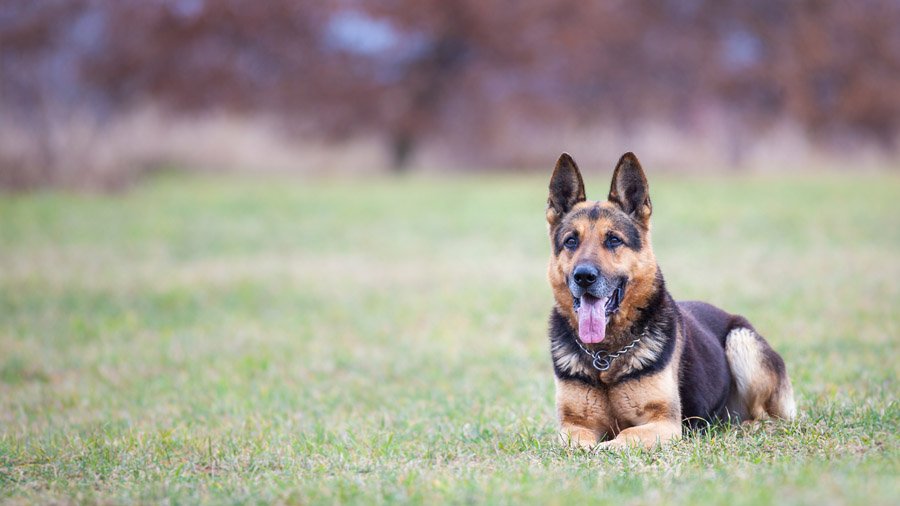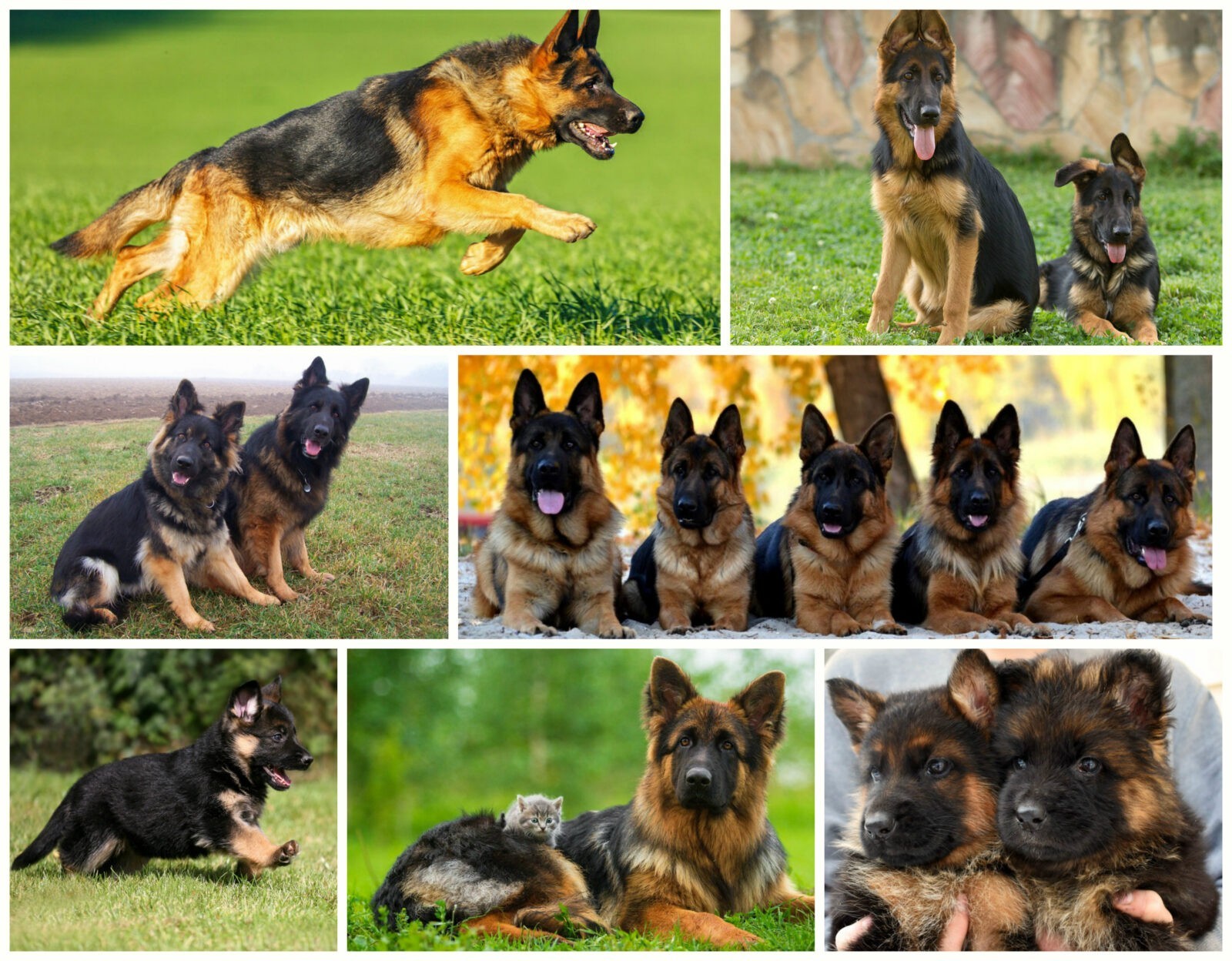Немецкие овчарки — это удивительно преданные своему хозяину, умные и благородные собаки. Появившись в конце 19-го века в Германии, немецкие овчарки в основном приобретались в качестве помощников в перегоне и выпасе скота. Но их врожденные качества — уравновешенность, послушание, быстрая реакция в нестандартных ситуациях сделали немецких овчарок отличными служебными собаками, поводырями для слепых и слабовидящих людей. Часто собаки такой породы приобретаются для охраны территории и в качестве четвероногого друга всей семьи. И в подавляющем большинстве случаев они справляются с поставленными задачами превосходно.

Краткое описание породы немецкая овчарка
Плюсы породы немецкая овчарка
- Идеальная семейная собака;
- Сильно привязывается к владельцу;
- Немецкие овчарки очень умные;
- Представители этой породы легко поддаются дрессировке;
- Прекрасно ладят с детьми разного возраста;
- Являются отличными защитниками и сторожами;
- Достигают успехов во многих собачьих соревнованиях;
- При правильном воспитании, становятся ответственными и надежными;
- За ними легко ухаживать.
- Не лучший выбор для тех, кто впервые заводит собаку;
- Могут проявлять агрессию в отношении чужих собак;
- Нуждаются в большом количестве тренировок и умственной нагрузке;
- Кобели могут проявлять доминирование;
- Сильно линяют;
- Могут страдать некоторыми наследственными заболеваниями;
- Нежелательно содержать их в квартире.
Основная информация
| Название породы: | Немецкая овчарка |
| Страна происхождения: | Германия |
| Время зарождения породы: | конец XIX века |
| Тип: | пастушьи и скотогонные |
| Вес: | 20 – 45 кг |
| Рост (высота в холке): | 55 – 65 см |
| Продолжительность жизни: | 10 – 15 лет |
|
Классификация МКФ:
|
Группа 1, Секция 1, Номер 166 |
| Цена щенков: | 120 – 1500 $ |
| Самые популярные клички: | список кличек для немецкой овчарки |
Оценка характеристик породы немецкая овчарка
| Адаптивность
(определение, означающее, насколько легко собака может приспосабливаться к изменениям в жизни) |
🐶🐶🐶🐶🐶 |
| Уровень линьки
(Уровень и частота выпадения волос у животного) |
🐶🐶🐶🐶🐶 |
| Уровень нежности
(Уровень и количество нежности и ласки, которую собака отдает взамен на внимание к себе) |
🐶🐶🐶 |
| Потребности в упражнениях
(Уровень дневной активности собаки) |
🐶🐶🐶 |
| Социальная потребность
(Необходимое количество контактов собаки с другими животными, а также людьми) |
🐶🐶🐶 |
| Квартирное содержание
(Фактор, определяющий уровень шума и иных неудобств, которые собака может доставлять хозяевам в соотношении размера квартиры к размеру собаки) |
🐶🐶🐶 |
| Груминг
(Количество купаний, расчесываний, а также необходимое количество сеансов профессионального груминга, необходимого собаке) |
🐶🐶🐶 |
| Дружелюбность в незнакомой среде
(Особенности поведения собаки в обществе с незнакомыми людьми или в незнакомой обстановке) |
🐶 |
| Тенденция к лаю
(Склонность к лаю и его частоте и громкости) |
🐶🐶 |
| Вопросы здоровья
(Потенциальный уровень состояния здоровья собаки) |
🐶🐶🐶🐶 |
| Территориальность
(Склонность собаки к защите своего дома, двора или даже автомобиля хозяина) |
🐶🐶🐶🐶🐶 |
| Дружелюбность к котам
(Тенденция к терпимости к кошкам и пониженное проявление охотничьих инстинктов) |
🐶🐶🐶 |
| Интеллект
(Способность собаки к мышлению и решению возникающих трудностей (не стоит путать с обучаемостью!) |
🐶🐶🐶🐶🐶 |
| Воспитание и дрессировка
(Уровень сложности в обучении собаки выполнять определенные действия) |
🐶🐶🐶🐶🐶 |
| Дружелюбность к детям
(Фактор, определяющий насколько собака дружелюбна к детям, любит ли она с ними играть и терпеть некоторые детские шалости) |
🐶🐶🐶🐶🐶 |
| Игровая активность
(Понятие определяется самим его названием, и, как правило, встречается почти у всех собак) |
🐶🐶🐶 |
| Наблюдательность
(Способность собаки определить присутствие чужого на своей территории) |
🐶🐶🐶🐶🐶 |
| Дружелюбность к другим собакам
(Склонность собаки находить общий язык с другими своими сородичами) |
🐶🐶 |
Внешний вид немецкой овчарки
Внешний вид собак этой породы прекрасно знаком каждому жителю нашей страны, поскольку эти животные чаще других появляются в телевизионных фильмах и сериалах. Немцы имеют пропорциональное сложение, строение их крепкое, мускулистое. Голова овчарок имеет удлиненную клинообразную форму, шея массивная, мускулистая, низ спины опущен к крупу, конечности длинные, параллельны относительно друг друга. Для немецких овчарок характерны больше среднего размера уши треугольной формы, миндалевидные медово-коричневые глаза, нос и губы имеют темную (черную) пигментацию.
Немецкие овчарки могут быть как длинношерстными (удлиненная грубоватая шерсть в областях ушей, хвоста), так и гладкошерстными. Бытующее мнение, что длинношерстные овчарки являются метисами (рожденными от скрещивания немецкой овчарки и собаки другой породы) не является правдой, поскольку у гладкошерстных родителей зачастую рождаются длинношерстые детеныши. Однако в 2010 году длинношерстные овчарки были признаны отдельной породой, хотя повадки и основные черты характера, что у собак с более короткой, что с более длинной шерстью абсолютно идентичны.
Немецкая овчарка фото:

История происхождения немецкой овчарки
Самым значимым человеком, отдавшим почти 40 лет своей жизни на благо появления и процветания породы, принято считать отставного капитана немецкой кавалерии по имени Макс Эмиль Фредерик фон Штефаниц. Военная карьера была выбрана фон Штефаницем по воле матушки, тогда как сам он мечтал заниматься сельским хозяйством. Не раз молодой капитан наблюдал за пасущимися большими отарами овец и собаками-пастухами, которые и по своему размеру, и по численности уступали парнокопытным. Но собаки справлялись с вверенными им стадами блестяще — без лишней суеты, быстро, не позволяя овцам разбредаться по округе. В то время (приблизительно в 1880-1890 г.г.) всех пастушьих собак называли овчарками (от слова овчар — овечий пастух), что не значило, что все животные для выпаса скота были одной породы. Идеей фон Штефаница было явить свету такую породу, которая бы сочетала в себе наилучшие качества овчарок того времени. Причем помимо помощи в пастушьем деле, собака, по мнению фон Штефаница должна была обладать такими чертами, которые могли стать ценными в служебном деле. И качества эти были такие: выносливость, послушание, верность, сообразительность, умение заступиться за стадо и пастуха.
Фон Штефаниц, оставивший военную службу, занялся вплотную выведением новой породы, основав в 1890-х известное Общество «Немецкая овчарка». Скрещивая лучших особей, основатель породы совершенствовал процесс, отмечая малейшие нюансы, которые влияли на качество потомства. В 1899 году фон Штефаниц приобрел на выставке овчарку, кобеля, которому дал имя Хоранд фон Графрат. Именно этот пес был внесен в племенную книгу Общества первым, став «отцом» немецких овчарок. В этом животном объединялись все те качества, которые так нравились фон Штефаницу и были так необходимы для пастушьего дела. Хоранд впоследствии скрещивался с суками, подходящими ему по типу и темпераменту, а Штефаниц выявлял дефекты у щенков, наблюдал за особенностями молодняка. Собаки Общества постоянно участвовали в выставках, где победителями становились лучшие представители породы. Количество участников Общества со временем росло, рос и интерес к немецким овчаркам. Постепенно эти собаки обрели популярность в рядах полиции, помогая выслеживать преступников. Со временем они стали поступать и на военную службу, внеся огромный вклад во время Первой мировой войны – они занимались поиском раненых солдат, помогали в патрулировании, карауле.
Основатель породы самолично занимался проблемами племенной работы и сохранением служебных качеств немецких овчарок, когда нечистые на руку дельцы пытались скрещивать собак без необходимых для этого знаний. Результатом бесконтрольной работы становились щенки с неустойчивой психикой, отклонениями в физическом развитии. Фон Штефаниц прикладывал все силы, чтобы выведение породы происходило по правилам. К примеру, для улучшения качеств и однородности типа собак было принято скрещивать близкородственных особей. По-настоящему популярной порода стала в 1920-е, а упадок пришелся на период Второй мировой, когда общество Германии и всего мира было далеко от проблем разведения и улучшения всех пород собак. В 1937 году, фактически отстраненный нацистами от дела всей своей жизни, фон Штефаниц скончался. И только в мирное время, после прекращения военных действий, последователи его дела возродили и сохранили по крупицам породу, благодаря чему немецкие овчарки по праву являются популярнейшими во всех странах.
Характер немецкой овчарки
Содержание и уход
Такие собаки требуют активного образа жизни, поэтому хозяину следует совершать с немцем ежедневные прогулки (желательно 2-3 раза в день не менее 1 часа), игры на свежем воздухе обязательны. Замечательно, если у владельца собаки будет возможность вылазок на природу (в лес, парк, рощу и т.д.), эти животные отлично чувствуют себя на воле. Лучше всего, чтобы такая собака проживала с человеком, который сможет уделять ей достаточно времени для прогулок и общения.
Они могут содержаться как в квартире, так и в уличных вольерах, при условии, что владелец позаботится о наличии утепленной будки и отсутствии сквозняков. Шерсть овчарок достаточно густая и длинная, что особенно во время линьки может способствовать появлению волосяных комков на полу, мебели. Регулярное вычесывание (не менее 3-4 раз в неделю), к которому следует приучать собаку с раннего возраста, поможет избежать такой проблемы. Кстати, немцы очень любят процедуру вычесывания, так что для них это будет совмещением приятного с полезным. Купание собак не должно проводиться чаще 2-3 раз в год, особенно в тех случаях, когда животное содержится не в квартире. Когти собаки должны подстригаться 1-2 раза в месяц, такая процедура может проводиться владельцем самостоятельно или же быть доверена грумеру, который наряду со стрижкой когтей позаботится о комплексном уходе за животным. Владельцу следует обращать внимание на состояние здоровья глаз, ушей немца, следить за походкой, температурой, общим состоянием и настроением питомца. А при случае обязательно обращаться к ветеринару, не пытаясь заниматься самолечением.
В качестве питания для собак породы немецкая овчарка подойдет сухой корм (желательно супер-премиум или холистик). В случае если владелец пожелает самостоятельно продумывать меню для четвероногого друга, стоит помнить, что в рационе собаки обязательно должны присутствовать натуральное нежирное мясо (более 30 %), субпродукты, творог, кисломолочные продукты, каши (овсянка, рис), сырые и отваренные овощи. От острых трубчатых костей, картофеля, пищи, сдобренной специями, следует отказаться.
Дрессировка и обучение
Здоровье и болезни порода немецкая овчарка
Собаки, приобретенные у хороших заводчиков, редко имеют слабое здоровье. Иногда немецкие овчарки страдают дисплазией тазобедренных суставов, но это проблема может преследовать не только крупных собак, но и мелких. У немцев дисплазия в редких случаях может обретать тяжелые формы. Своевременный осмотр у врача, рентгеновские снимки и правильное лечение на ранних стадиях болезни позволит собаке жить полной жизнью, не прихрамывая и припадая на лапы.
У некоторых немецких овчарок присутствует неуемный аппетит, что и неудивительно при их любви к физическим нагрузкам. Владельцу не следует закармливать собаку, поскольку овчарки склонны к быстрому набору веса и ожирению, что приводит ко многим проблемам. Немцы иногда страдают от болезней, вызванных воспалением ушей, поэтому владельцу следует внимательно следить за собакой, когда она трясет головой или склоняет ее неестественно набок, если появляются нехарактерные выделения из ушных раковин. Но в большинстве случае овчарки — здоровые существа, которые отлично переносят перепады температуры, они развиты физически, активны. Своевременное посещение ветеринара, вакцинация, профилактика паразитов позволяют хозяину иметь здоровую собаку.
Несколько интересных фактов
- Немецкие овчарки входят в десятку самых популярных пород собак в мире.
- Они доказали свою ответственность и надежность в период, когда принимали участие в мировых войнах в качестве почтовых и сторожевых собак.
- Система тренировок «шутцхунд» была разработана в 1900 году для дрессировки немецких овчарок.
- Макс фон Штефаниц известен как «отец породы».
- Немецкие овчарки считаются первыми собаками-поводырями.
- Немецкие овчарки отличаются острым умом. Их нельзя доводить до состояния агрессивности и нервозности!
- Они не любят однообразный образ жизни, поэтому животное не относится к категории домоседов. Это очень активная собака, которая подойдет такому же активному хозяину.
- Они обожают детей. Такие четверолапые — отличный выбор для семей с детьми. Важным моментом для таких семей является ранняя социализация животного.
- Многие ошибочно считают, что немецкая овчарка может иметь исключительно черно-палевый окрас. На самом деле это не так. Собаки этой породы могут быть полностью черного цвета, или иметь комбинированный окрас из белого и песочного или белого и черного цветов. Недобросовестные собаководы часто пытаются продать собак с таким окрасом по более высокой цене, мотивируя это редкостью расцветки.
- Ни одна порода собак не удостаивалась такой почести, чтобы о ней снимали столько фильмов и сериалов. Интересные, местами трогательные фильмы, которые знакомы любому россиянину много лет — «К-9: Собачья работа», «Комиссар Рекс», «Верный Руслан» и многие другие. Без сомнения можно сказать, что в некоторых сценах актерам было далеко до умной и берущей за душу своей искренностью немецкой овчарки.
- В 2003 году в Тольятти установлен Памятник преданности, который представляет глядящего вдаль пса породы немецкая овчарка. Это вовсе не собирательный образ, пронзительная до глубины души история, которая и послужила поводом для установки памятника, произошла на самом деле. Пес, чьего имени никто не знал (в народе его прозвали Константином, поскольку значение этого имени – «верный»), выжил в аварии в 1995 году. Его хозяин погиб, а пес ежедневно приходил на место трагедии и ждал его 7 лет. 7 лет!!! Много добросердечных людей старалось приютить пса, но он нигде не ужился, вырывался, чтобы вернуться на место гибели своего друга. В 2002 году пес умер, а люди, пораженные примером верности дружбе, сбросились деньгами, чтобы увековечить память, ведь способны на такую верность далеко не все.
Питомники и заводчики
Материал мы заимствовали с замечательного сайта наших партнеров DOGCATFAN.COM о кошках и собаках, автор dogcatfan
